There are lots of things you can do to deter a bear from approaching you or hanging around your campsite. Special precautions are necessary when deterring a grizzly (brown) bear. Bear spray and electric fences are appropriate tools to use, but only trained individuals should attempt to deter a grizzly bear with noise deterrents or other physical deterrents. Be sure to read the section on bear encounters first. (Click here to learn how to tell the difference between a grizzly bear and a black bear.)
Personal Protection
Bear Spray
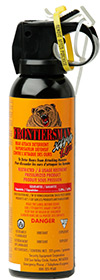 Bear spray is the most effective means of repelling an attacking grizzly or black bear in a non-toxic, non-lethal manner. Although common sense might suggest that guns would provide greater personal protection, research and experience indicates that human-bear encounters that do not involve firearms are less likely to result in injury to a human or bear.
Bear spray is the most effective means of repelling an attacking grizzly or black bear in a non-toxic, non-lethal manner. Although common sense might suggest that guns would provide greater personal protection, research and experience indicates that human-bear encounters that do not involve firearms are less likely to result in injury to a human or bear.
According to a U.S. Fish and Wildlife Service report, law enforcement agents and experienced hunters who use firearms to defend themselves suffer injury about 50 per cent of the time, while people defending themselves with bear spray escape injury most of the time and injuries that did occur were less severe (U.S. Fish and Wildlife Service). University of Calgary’s Dr. Stephen Herrero found similar results. This is why bear spray is often carried in the backcountry by biologists, professional guides and hikers/campers.
The aerosol can shoot bursts of atomized capsaicin (a red pepper derivative) up to eight metres, though the spray is most effective at short range. It is ideal for personal defense use when hunting, camping, fishing, hiking and biking or whenever enjoying the great outdoors in bear habitat.
Even a skilled marksman with steady nerves may have a slim chance of deterring a bear attack with a gun. – U.S. Fish and Wildlife Service
Not all bear sprays are the same. Ensure that you are using a bear deterrent spray, not a personal defense product designed for use on people or dogs. Follow the directions and check the product’s shelf-life. Try to carry at least two canisters per group.
Nothing can replace good sense and proper safety measures. People whose activities may possibly put them in a situation where they may encounter a bear or other wild animal should educate themselves and be aware of the potential for an attack.
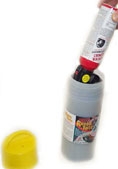 Warning: the spray is explosive and extremely flammable and should be transported in an appropriate carrier. When transporting bear spray, always make sure the safety is securely in place and will not fall out. Bear spray should never be transported inside the passenger area of any vehicle or airplane unless in a fully sealed, enclosed container.
Warning: the spray is explosive and extremely flammable and should be transported in an appropriate carrier. When transporting bear spray, always make sure the safety is securely in place and will not fall out. Bear spray should never be transported inside the passenger area of any vehicle or airplane unless in a fully sealed, enclosed container.
To purchase: contact Kodiak Wildlife Products Inc. Get a complete bear safety kit.
Get more detailed information.
Hand-held marine flares
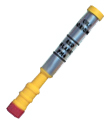 Hand-held marine flares are a great tool for wilderness use. They are an effective bear deterrent and can also be used as a beacon for rescuers in the case of emergency. Hand-held flares are effective because they affect more than one of the bear’s senses – sight, smell and hearing.
Hand-held marine flares are a great tool for wilderness use. They are an effective bear deterrent and can also be used as a beacon for rescuers in the case of emergency. Hand-held flares are effective because they affect more than one of the bear’s senses – sight, smell and hearing.
This is the preferred bear deterrent used by bear viewing guides on the Alaska coast. Choose a flare that ignites by pulling a string rather than by striking. Be careful not to drop flares in dry conditions until they are fully extinguished as they can be a fire hazard if not hand held.
Signal flares should never come in physical contact with the bear. If used properly, signal flares do not inflict any physical pain, harm or lasting discomfort to the bear.
Bear Bangers and Launchers
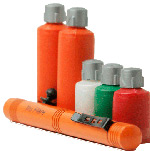 Scare cartridges (bangers, flares and whistling screamers) are practical, inexpensive, easy-to-use and very effective bear deterrents. They can be fired from pen launchers or pistols. Both systems are highly effective, so the system you choose is simply a matter of personal choice. Pen launchers are easier to carry in a backpack, but pistols are often used by wildlife officers because they can carry multiple rounds.
Scare cartridges (bangers, flares and whistling screamers) are practical, inexpensive, easy-to-use and very effective bear deterrents. They can be fired from pen launchers or pistols. Both systems are highly effective, so the system you choose is simply a matter of personal choice. Pen launchers are easier to carry in a backpack, but pistols are often used by wildlife officers because they can carry multiple rounds.
Because they use explosives, bangers must be used very carefully under dry conditions. Care should also be taken as the cartridges will ricochet if they hit an obstruction such as a tree branch.
To avoid injury to bears, bangers should only be fired from the proper distance so that they do NOT hit the bear. Bangers must be fired between you and the bear – if they are fired behind the bear, it may cause the bear to advance toward you to get away from the explosion. All shooters must know the optimal range of their rounds as they can cause death (Hunt 2003).
Pen launchers and bangers can be purchased from Kodiak Wildlife Products Inc. Please carefully review the safety considerations here before using.
Wildlife Deterrent Horn
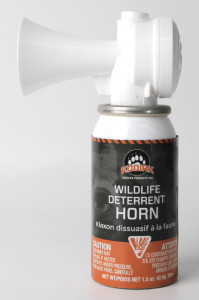 Wildlife Deterrent horns can be an effective means of scaring bears away. They are small, light and easy to use, perfect for backcountry or home use.
Wildlife Deterrent horns can be an effective means of scaring bears away. They are small, light and easy to use, perfect for backcountry or home use.
The Falcon Supersound weighs just 1.5 oz and emits a piercing blast that can be heard up to 1/2 mile away. It’s 100 per cent ozone safe and non-flammable.
To purchase: contact Kodiak Wildlife Products Inc. Get a complete bear safety kit.
Camp Protection
Electric fencing
Portable electric fencing is a relatively simple and cost-effective way to secure your camp.
The Deterring Bears with Electrified Fencing: A Beginner’s Guide by Montana Fish, Wildlife & Parks contains pertinent electric fencing information with key considerations for portable or temporary installments:
“…There are many prefabricated electrified netting fences that are quick to install and easy to move. A fence constructed of polywire and plastic or fiberglass posts can be quickly set up and used seasonally or for short periods of time…while these fences are easier to construct than permanent fences, temporary fencing designs require more regular maintenance than permanent fencing to keep them running at optimal performance.” (pg. 3)
“For temporary, seasonal or portable electrified fencing, consider the use of polyethylene wire, also called polywire (Figure 4). Polywire consists of many strands of wire braided within a polyethylene rope. Polywire is flexible, strong and can be unrolled and re-rolled multiple times without breaking. It is recommended that your polywire have at least 9-strands of wire imbedded within the polyethylene. Polywire will degrade and break after long exposures to sun. Polytape, which is flat instead of rope-like, is less effective for deterring bears and not recommended.” (pg. 10)
Please see our electric fencing page for more information on this useful tool.
